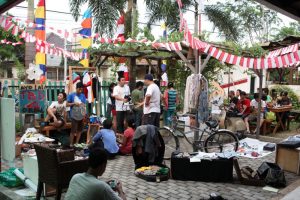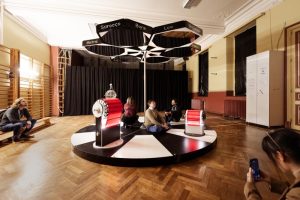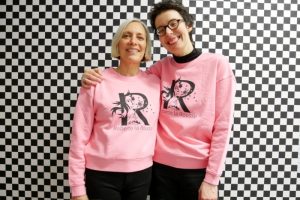Here’s a short recap of good stuff at SIGGRAPH in Boston. While the conference itself was pretty focused on the technical or business aspects of computer graphics, there were some gems to be found, especially in the Emerging Technologies and Art exhibitions:
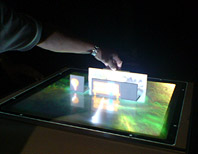
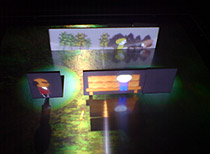 Tablescape Plus is a clever display technology that was developed at the University of Tokyo. It mainly consists of L-shaped pieces of plastic that are sitting on an illuminated table. On the upright side of each piece there is a perfectly planar projection that is coming from inside the table. The objects are being tracked from below as well. The trick is that its surface is actually a special Fresnel lens, a technology that the researchers fancied calling “Lumisty”. Especially cute was the demo software which was a projected group of people – Japanese salarymen and their boss. Depending on how you would arrange the pieces, the little people would get embarrassed or hide behind trees and much more.
Tablescape Plus is a clever display technology that was developed at the University of Tokyo. It mainly consists of L-shaped pieces of plastic that are sitting on an illuminated table. On the upright side of each piece there is a perfectly planar projection that is coming from inside the table. The objects are being tracked from below as well. The trick is that its surface is actually a special Fresnel lens, a technology that the researchers fancied calling “Lumisty”. Especially cute was the demo software which was a projected group of people – Japanese salarymen and their boss. Depending on how you would arrange the pieces, the little people would get embarrassed or hide behind trees and much more.
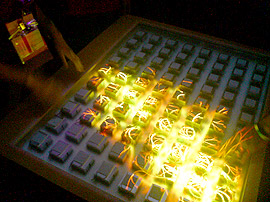 An interesting display technology was the Thermoesthesia that their makers also call a “Thermal sense display”. Beneath the projection surface there is a matrix of 24 heat pumps. When you touch the surface, you produce snow crystals or sparks, depending on the mode that the installation is currently in. The interesting thing is that the surface not only starts to visually freeze over but only gets icy to touch because of the heat pumps cooling down the respective spots. “A chance to rediscover the world” the researchers boldly claim.
An interesting display technology was the Thermoesthesia that their makers also call a “Thermal sense display”. Beneath the projection surface there is a matrix of 24 heat pumps. When you touch the surface, you produce snow crystals or sparks, depending on the mode that the installation is currently in. The interesting thing is that the surface not only starts to visually freeze over but only gets icy to touch because of the heat pumps cooling down the respective spots. “A chance to rediscover the world” the researchers boldly claim.
Jeff Han exhibited his Multi-Touch display which is as simple and makes as much sense as in all of the videos on the web. Especially the dynamic map that you can spin around and zoom in and out works marvellously. Just don’t say “Minority Report” or he might hit you.
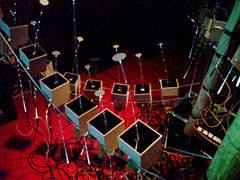 Jee Hyun Oh from Ravensbourne college in London showed the second iteration of her GORI.Node Garden (Here’s the first one) in which she advanced the original idea to be a collaborative rather than a personal data garden. During the conference, people could log on to her IM-system, chat with her and once the conversations had ended, they could chose which of the GORI-nodes to “water” which then would react and grow.
Jee Hyun Oh from Ravensbourne college in London showed the second iteration of her GORI.Node Garden (Here’s the first one) in which she advanced the original idea to be a collaborative rather than a personal data garden. During the conference, people could log on to her IM-system, chat with her and once the conversations had ended, they could chose which of the GORI-nodes to “water” which then would react and grow.
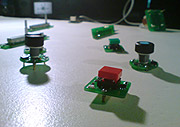 Another nice project from the UK was VoodooIO, a system that uses a soft, almost leathery surface, in which then different elements like buttons or sliders can be pinned. The controllers communicate through two layers of conductive fabric with their master computer that is also connected to the fabric. It’s a bit like you have this home entertainment system and instead of using a giant remote control you just pin a few buttons into your couch to control it.
Another nice project from the UK was VoodooIO, a system that uses a soft, almost leathery surface, in which then different elements like buttons or sliders can be pinned. The controllers communicate through two layers of conductive fabric with their master computer that is also connected to the fabric. It’s a bit like you have this home entertainment system and instead of using a giant remote control you just pin a few buttons into your couch to control it.
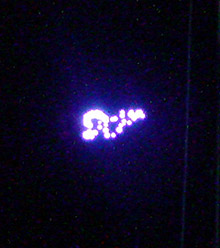 The most impressive piece of the show was arguably the Laser Plasma Display of which images had been around for some time already. They use a high energy laser to create a controllable plasma-emission phenomenon in mid air. This means that this technology can make spots in the air light up at will, in full 3D. The visual effect is very much like that of super-bright LEDs but at the same time there’s a very loud crackling from the rapidly expanding air and a strong smell of ozone. The fact that the Japanese technicians were all wearing dark safety-goggles only added to the show. According to the developers, one of the intended goals is to be able to create gigantic three-dimensional displays above buildings to be used as “aerial advertisements”.
The most impressive piece of the show was arguably the Laser Plasma Display of which images had been around for some time already. They use a high energy laser to create a controllable plasma-emission phenomenon in mid air. This means that this technology can make spots in the air light up at will, in full 3D. The visual effect is very much like that of super-bright LEDs but at the same time there’s a very loud crackling from the rapidly expanding air and a strong smell of ozone. The fact that the Japanese technicians were all wearing dark safety-goggles only added to the show. According to the developers, one of the intended goals is to be able to create gigantic three-dimensional displays above buildings to be used as “aerial advertisements”.
People very much loved a project U-Tsu-Shi-O-Mi which was conceived by developers at NTT DoCoMo. It’s basically a green fluffy humanoid figure with a robot in it. 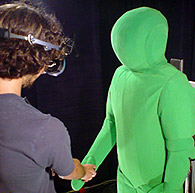
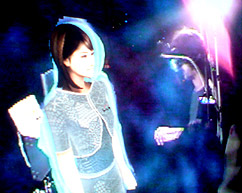 The user puts on an augmented reality headset and suddenly the figure looks like…your favorite J-pop celebrity (the explanatory sheet featured Tom Cruise as well). The artificial star then asks you to shake her burning (!) robot-hand with yours that through the headset looks very computer-generated as well, changes gender a few times in an explosion of sparks and all in all creates a very confusing yet enjoyable and completely Japanese idea of immersive media.
The user puts on an augmented reality headset and suddenly the figure looks like…your favorite J-pop celebrity (the explanatory sheet featured Tom Cruise as well). The artificial star then asks you to shake her burning (!) robot-hand with yours that through the headset looks very computer-generated as well, changes gender a few times in an explosion of sparks and all in all creates a very confusing yet enjoyable and completely Japanese idea of immersive media.
At the SIGGRAPH trade fair outside of the exhibition it was Google that stood out with some work related to Google Earth. Michael Jones who is the CTO of the software gave me a very insightful demo of the “coverage” of the conflict between Israel and Lebanon that is happening on GE. As he pointed out, there have been some controversial discussions inside of Google on whether and when to update the aerial pictures of Beirut and northern Israel to not influence the course of the conflict. They did have some very new footage of Beirut though which was truly shocking and for him the proof that this kind of information eventually always is about people. 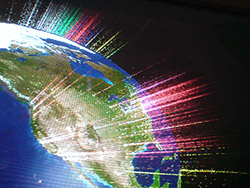 Another nice visualization was right next to it: a spinning globe on which searches on Google are displayed in real-time as slowly rising dots in reference to their location and color-coded according to language. Very simple in the way that it almost displayed individual “thoughts” of people and at the same time showed that some parts of the US are effectively bilingual already.
Another nice visualization was right next to it: a spinning globe on which searches on Google are displayed in real-time as slowly rising dots in reference to their location and color-coded according to language. Very simple in the way that it almost displayed individual “thoughts” of people and at the same time showed that some parts of the US are effectively bilingual already.
I’m gonna be at ISEA in San Jose for the next week. If there’s anything happening you think we should know of, please get in touch: me(insert@here)plugimi.com

